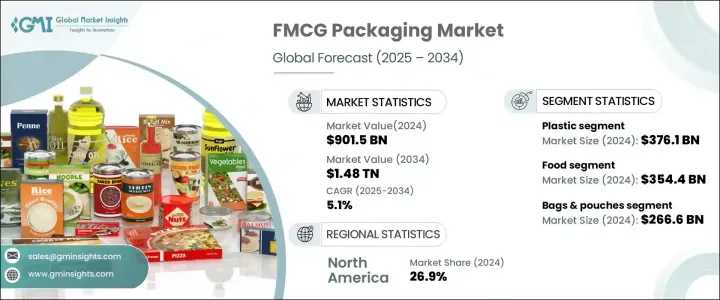
세계의 FMCG 포장 시장은 2024년에 9,015억 달러로 평가되며, 2025-2034년에 CAGR 5.1%로 성장할 전망입니다.
급속한 도시화, 소비자 취향의 변화, E-Commerce 플랫폼의 확산으로 인해 FMCG 시장의 성장이 가속화되고 있으며, FMCG 부문의 경쟁이 치열해짐에 따라 브랜드는 제품 차별화를 강화하고 소비자의 관심을 끌기 위해 혁신적이고 지속가능한 포장 솔루션에 중점을 두고 있습니다. 하고 있습니다. 편리하고 바로 먹을 수 있는 식품에 대한 수요 증가와 지속가능한 재료에 대한 관심이 높아지면서 이러한 성장에 더욱 박차를 가하고 있습니다.

또한 DTC(Direct-to-Consumer) 모델과 구독 기반 서비스의 확대로 인해 제품의 안전성을 보장하고 운송 중에도 품질을 유지하는 포장에 대한 요구가 증가하고 있습니다. 환경적 지속가능성에 대한 소비자의 인식이 높아지면서 브랜드들은 기능성과 시각적 매력을 유지하면서 폐기물을 최소화하는 포장 솔루션을 적극적으로 모색하고 있으며, QR코드 및 NFC 태그와 같은 스마트 포장 기술의 통합은 추적성을 강화하고, 소비자에게 실시간 정보를 제공함으로써 실시간 정보를 제공함으로써 시장의 성장 가능성을 더욱 높이고 있습니다. 규제 당국이 환경 가이드라인을 강화함에 따라 FMCG 포장 산업은 예측 기간 중 생분해성, 재활용 및 재사용이 가능한 재료로 전환할 것으로 예측됩니다.
| 시장 범위 | |
|---|---|
| 시작연도 | 2024년 |
| 예측연도 | 2025-2034년 |
| 시작 금액 | 9,015억 달러 |
| 예상 금액 | 1조 4,800억 달러 |
| CAGR | 5.1% |
시장은 플라스틱, 종이/판지, 금속, 유리, 생분해성 재료 등의 재료에 따라 분류됩니다. 플라스틱 포장은 2024년 3,761억 달러를 차지할 것으로 예상되며, 비용 효율성, 내구성, 다용도성 등으로 인해 지배적인 위치를 차지하고 있습니다. 이 부문의 성장은 급속한 도시화, FMCG 브랜드의 세계 확장, 확장 가능하고 가벼운 포장에 대한 수요 증가로 인해 촉진되고 있습니다. 플라스틱은 습기, 산소, 오염으로부터 제품을 보호하는 우수한 장벽 특성을 가지고 있으며, 식품, 식품 및 음료, 퍼스널케어 분야에서 선호되고 있습니다. 환경에 미치는 영향에 대한 우려가 커지고 있지만, 생분해성 플라스틱과 재활용 가능한 소재의 발전은 이러한 문제를 완화하고 이 부문의 성장을 지원하고 있습니다.
용도별로 FMCG 포장 시장은 식품, 식품 및 음료, 퍼스널케어 및 화장품, 가정용품, 기타 카테고리로 나뉩니다. 식품 부문은 2024년 3,544억 달러 시장을 창출했으며, 이는 포장된 즉석식품에 대한 소비자 수요 증가에 기인합니다. 바쁜 라이프스타일로 인해 소비자들이 편리함을 추구함에 따라 식품 안전, 신선도 유지, 변조 방지 솔루션을 제공하는 포장에 대한 요구가 계속 증가하고 있습니다. 온라인 식료품 플랫폼과 밀키트 서비스의 확산은 환경에 미치는 영향을 최소화하면서 운송 중에도 제품을 보호할 수 있는 가볍고 내구성이 뛰어난 포장에 대한 수요를 증가시키고 있습니다. 또한 신선식품의 보존성을 향상시키는 기능성 포장의 등장으로 이 부문의 성장이 더욱 가속화되고 있습니다.
북미 FMCG 포장 시장은 2024년 26.9%의 점유율을 차지하며, 제품 차별화에 대한 수요 증가와 스마트 포장 기술 도입으로 인해 강력한 성장을 이룰 것으로 전망됩니다. 친환경적이고 지속가능한 포장 솔루션에 대한 정부의 지원과 제품 안전 및 추적 가능성에 대한 소비자의 관심이 높아지면서 이 지역 시장 확대에 기여하고 있습니다. 브랜드들이 실시간 추적을 제공하고 제품의 무결성을 보장하는 스마트 포장 솔루션에 투자함에 따라 북미 시장은 향후 수년간 상승세를 이어갈 것으로 예측됩니다.
The Global FMCG Packaging Market, valued at USD 901.5 billion in 2024, is poised to grow at a CAGR of 5.1% between 2025 and 2034. Rapid urbanization, changing consumer preferences, and the growing penetration of e-commerce platforms are driving significant growth across this market. As the FMCG sector becomes increasingly competitive, brands are emphasizing innovative and sustainable packaging solutions to enhance product differentiation and capture consumer attention. The rising demand for convenient, ready-to-eat options and increased focus on sustainable materials have further fueled this growth.

Additionally, the expansion of direct-to-consumer (DTC) models and subscription-based services is boosting the need for packaging that ensures product safety and maintains quality throughout transit. With growing consumer awareness about environmental sustainability, brands are actively seeking packaging solutions that minimize waste while maintaining functionality and visual appeal. The integration of smart packaging technologies, such as QR codes and NFC tags, is enhancing traceability and providing consumers with real-time information, further strengthening the market's growth potential. As regulatory bodies push for stricter environmental guidelines, the FMCG packaging industry is expected to pivot toward more biodegradable, recyclable, and reusable materials over the forecast period.
| Market Scope | |
|---|---|
| Start Year | 2024 |
| Forecast Year | 2025-2034 |
| Start Value | $901.5 Billion |
| Forecast Value | $1.48 Trillion |
| CAGR | 5.1% |
The market is segmented based on materials, including plastic, paper & paperboard, metal, glass, and biodegradable materials. Plastic packaging accounted for USD 376.1 billion in 2024, maintaining a dominant position due to its cost-effectiveness, durability, and versatility. The segment's growth is fueled by rapid urbanization, the global expansion of FMCG brands, and the increasing need for scalable and lightweight packaging. Plastic offers superior barrier properties that protect products from moisture, oxygen, and contamination, making it a preferred choice in the food, beverage, and personal care sectors. Despite growing concerns about environmental impact, advancements in biodegradable plastics and recyclable materials are helping to mitigate these issues and sustain the segment's growth.
In terms of application, the FMCG packaging market is divided into food, beverage, personal care & cosmetics, household products, and other categories. The food segment generated USD 354.4 billion in 2024, driven by the increasing consumer demand for packaged and ready-to-eat food options. As busy lifestyles push consumers toward convenience, the need for packaging that ensures food safety, maintains freshness, and offers tamper-evident solutions continues to grow. The proliferation of online grocery platforms and meal-kit services has heightened the demand for lightweight and durable packaging that protects products during transportation while minimizing environmental impact. Moreover, the rise of functional packaging that enhances the shelf life of perishable items has further fueled the growth of this segment.
North America FMCG packaging market held a 26.9% share in 2024, with strong growth driven by rising demand for product differentiation and the adoption of smart packaging technology. Government support for eco-friendly and sustainable packaging solutions, along with heightened consumer focus on product safety and traceability, is contributing to the regional market expansion. As brands invest in smart packaging solutions that offer real-time tracking and ensure product integrity, the North American market is expected to continue its upward trajectory in the coming years.